Abstract
Bangladesh, at 142 million people, is the ninth most populous country in the world. There are 13 to 15 lakh cancer patients in Bangladesh, with about two lakh patients newly diagnosed with cancer each year. As an overview, lung cancer and mouth-oropharynx cancer rank as the top two prevalent cancers in males. Other types of cancers are esophagus cancer and stomach cancer. In women, cancer cervix uteri and breast cancer are most prevalent. Other cancer types, which affect women, are mouth and oropharynx cancer, lung cancer, and esophagus cancer. There are around 150 qualified clinical oncologists and 16 pediatric oncologists working in the different parts of the country. Regular cancer treatment is available in 19 hospitals and 465 hospital beds are attached as indoor or day care facilities for chemotherapy in the oncology/radiotherapy departments. There are about 15 linear accelerators, 12 Co-60 teletherapy and 12 brachytherapy units currently available. Approximately, 56 cancer chemotherapeutic agents are obtainable in Bangladesh. Research facilities are available at tertiary care centers and a few multi country collaborative research activities are ongoing. Bangladesh has a unique National Cancer Control Strategy and Plan of Action 2009-2015 formulated with the assistance of WHO with an objective to develop and implement continuum of cancer care through a comprehensive cancer control programe. Preventive measures taken to reduce the incidence of cancer include reduced tobacco smoking, change of dietary habit and reduced food adulteration, ensuring reproductive hygiene, increased physical activity, and reduced occupational hazard. Awareness buildup and media campaign are going on by organizing the general people, opinion leaders of the society, and boy and girl scout. Training of general physicians on cancer warning signs and setup of early cancer detection centers at each medical college and district levels are ongoing. Beside these, some other major cancer programs have taken place for early detection of breast, cervical and oral cancer by Bangladesh Government and NGOs such as ICDDR’B, BRAC, Ahsania Mission Cancer Hospital, BSMMU, Bangladesh Cancer Society, Ashic Foundation, Amader Gram, AK Khan Healthcare Trust, CANSUP, Oncology club etc. Piloting of cervical cancer vaccination has recently been completed. Improving the cancer scenario overnight is not an easy task but policy makers may become interested and push this agenda forward, if the huge health impact and economic loss caused by cancer become evident to them. Besides, Bangladesh has accepted reduction of cancer morbidity and mortality targets set by United Nations and World Health Organization as a part of global non-communicable disease prevention agreement.
Keywords: Cancer, prevalence, facilities, prevention, cancer programme, agency, Bangladesh
Basic information on the oncology scenario, including the leading cancers, their prevalence, citing the causes of increased prevalence
Bangladesh, at 142 million people, is the 9th most populous country in the world. There are 13 to 15 lakh cancer patients in Bangladesh, with about 2 lakh patients newly diagnosed with cancer each year.[1,2]
As an overview, lung cancer and mouth and oropharynx cancer rank as the top 2 prevalent cancers in males. Other types of cancers commonly noted include esophagus cancer, stomach cancer, lymphomas, and multiple myeloma. In women, cervix uteri cancer and breast cancer are most prevalent. Other cancer types which affect women are mouth and oropharynx cancer, lung cancer, and esophagus cancer.[1] The prevalence rates of the leading cancers in both males and females are presented in Tables 1 and 2.[3]
Table 1.
Leading cancers and the prevalence in last 5 years in males
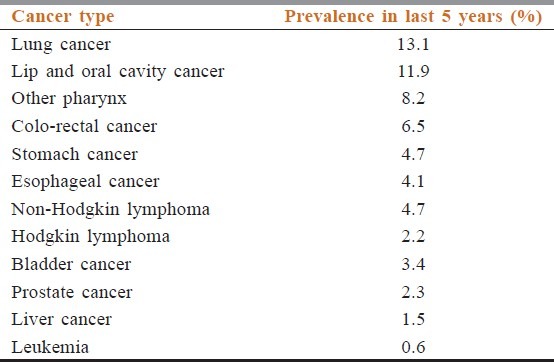
Table 2.
Leading cancers and the prevalence in last 5 years in female
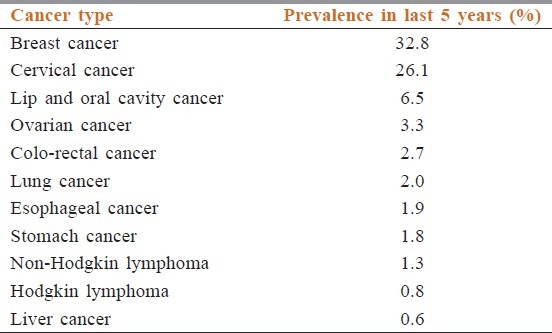
Causes of increased cancer prevalence
Tobacco
Tobacco smoke contains approximately 4000 chemicals, of which at least 438 can cause cancer. Tobacco is the single most important modifiable risk factor (30%) for cancer. Unfortunately, in Bangladesh, cigarette production has grown tremendously since 1980, and bidi production has grown even faster. A WHO study showed that 20 million people in Bangladesh use tobacco in some form, including five million women and 57,000 people die every year due to tobacco-related diseases. Smoking prevalence in Bangladesh is 41% among men aged 15 years and over. In women, it was 1.8% among those aged 15 years and over.[4]
Sexual and reproductive factors
Sexual and reproductive factors are associated with cancer of the uterine cervix and breast. Sexual behavior factors, like young age at first sexual activity, multiple sexual partners, and poor sexual hygiene, are associated with cancer of the uterine cervix. Human Papilloma Virus (HPV) has now been identified as the etiological agent responsible for cervical cancer. HPV prevalence increases with high-risk sexual behavior and poor sexual hygiene. Late age at marriage, nulliparity, and late menopause have been linked to breast cancer.[3]
Diet
Foods which are responsible for cancers of oral cavity, pharynx, larynx, esophagus, liver, and breast include red meat (cow, goat), sugar, artificial sweetener, tea, fried food, dried fish, preserved foods, food adulteration and soft drinks. Changing dietary patterns will lead to increased contribution of diet in cancer causation in Bangladesh.[4]
Obesity Physical inactivity Cancer-causing viral and bacterial infection
Human Papilloma virus, Hepatitis B and Hepatitis C virus, Epstein-Barr virus, Schistosoma haematobium, Helicobacter Pylori.
Basic facilities available in various parts of the country
Setting 1: Only basic care facilities
Only basic care and palliative oral treatment can be given in ASHIC Foundation. There are no oncology trained personnel available at the center and no specialized diagnostic facilities like histopathology, flow cytometry are available.
Setting 2: Regular cancer treatment facilities
According to International Atomic Energy Agency (IAEA), 2 teletherapy machines and 1 brachytherapy machine are needed for 1 million population. According to this estimation Dhaka city alone needs 20 and the entire country needs around 300 Teletherapy (radiotherapy) machines respectively.
However, in Bangladesh there are 17 radiotherapy centers in public and private sector; only one is situated in a rural area. There are only 15 Linear Accelerators installed in the country with two installed in a rural area. 12 Cobalt- 60 machines and 12 brachytherapy machines are installed in Bangladesh [Table 3].
Table 3.
Radiotherapy facilities available in Bangladesh[4]
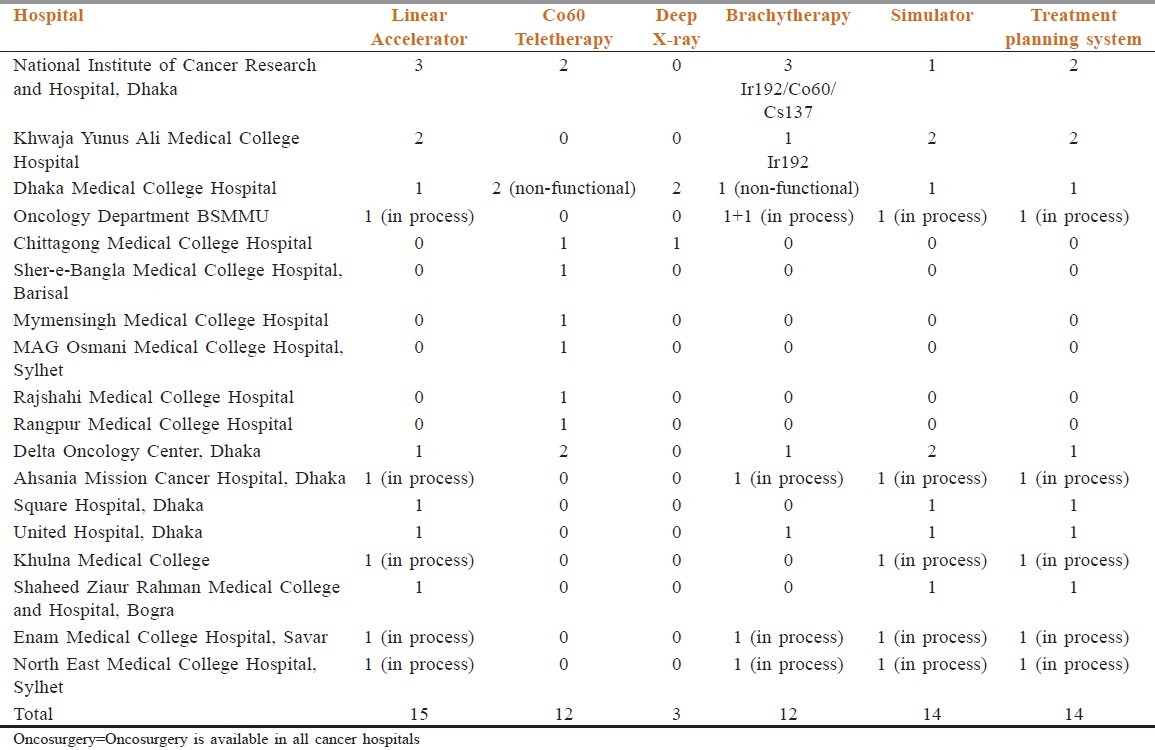

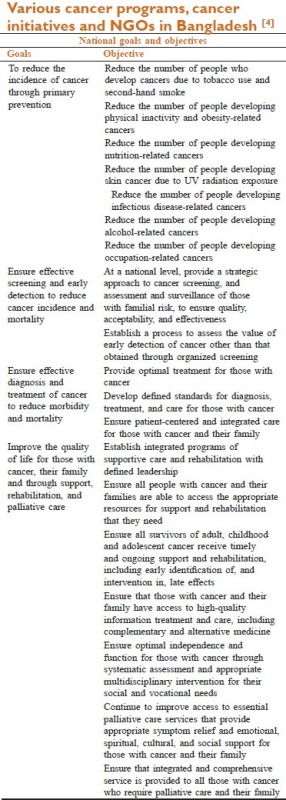
Bed capacity is around 500 beds all over the country which is insufficient for the current and future needs.[4] Among these, 64 beds are for day care and remaining are in indoor facility [Table 4].
Table 4.
Hospital beds attached to oncology/radiotherapy departments[4]
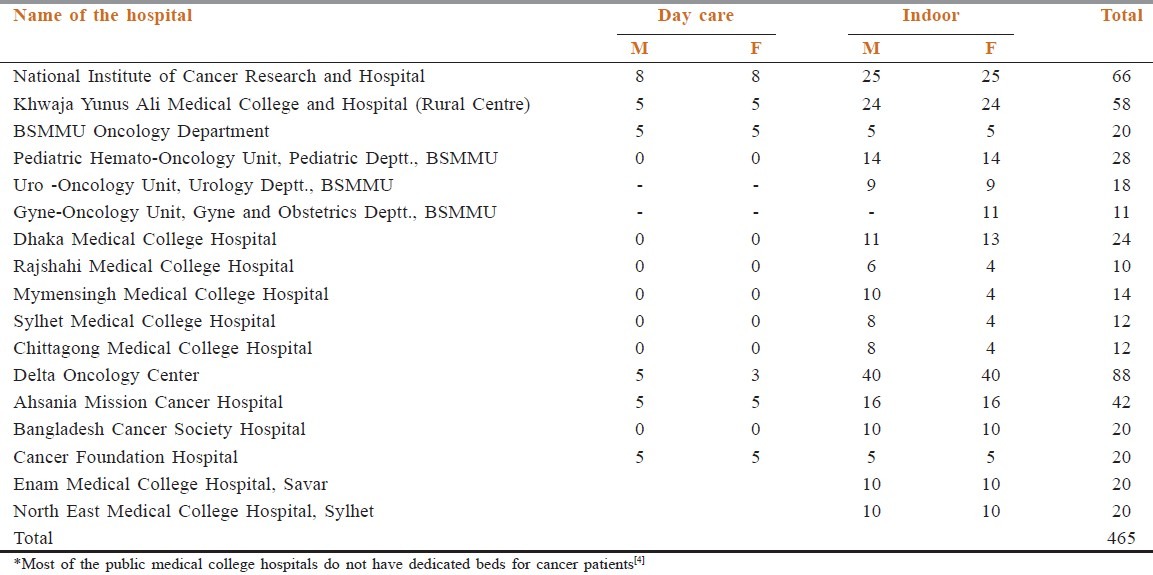
Oncologist available: There are 150 qualified oncologists.
Regular cancer treatment can be made available to patients in:
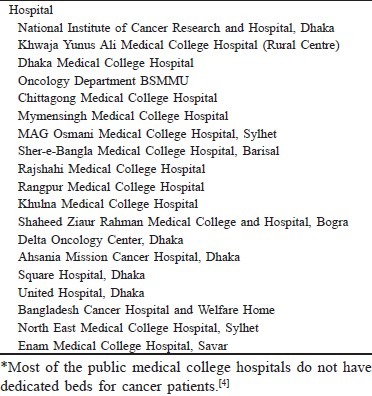
Setting 3 Tertiary care centers, with research facilities are available in
Bangabandhu Sheikh Mujib Medical University
National Institute of Cancer Research and Hospital (NICRH)
Khwaja Yunus Ali Medical College and Hospital- KYAMC Cancer Center
Dhaka Medical College Hospital
Sir Salimullah Medical College Hospital
Sher-E-Bangla Medical College Hospital, Barisal
Chittagong Medical College Hospital
Mymensingh Medical College Hospital
MAG Osmani Medical College Hospital, Sylhet
Rajshahi Medical College Hospital
Rangpur Medical College Hospital
Transplant facility: The only bone marrow transplant facility is available in Dhaka Medical College.
Cancer programs
Breast Cancer Identifying and Treating Project; Amader Gram an ICT4D initiative of Bangladesh.
The Government of Bangladesh, with support from UNFPA, has taken initiatives to develop a cervical and breast cancer screening program in Bangladesh.
International Childhood Cancer Forum: Exploration and setting priorities for an unmet need in Bangladesh.
The Bangladesh Women Chamber of Commerce and Industry has committed to raise the awareness of cervical cancer in every woman and every child.
CANSUP, an NGO in Chittagong, is working on breast self-examination and cervical cancer screening with technical assistance from WHO.
Gonoshasthaya Kendra is heading towards establishing a cancer hospital for the poor. The Government has already acquired the land, and Gonoshasthaya Kendra has started to mobilize resources and are requesting the philanthropists and donors to come forward in establishing the cancer hospital for the poor adjacent to Savar campus.
ASHIC Foundation for childhood cancer improves the quality of life for children living with cancer in Bangladesh by providing hope, physical and emotional support, and raising public awareness for early detection, improved treatment, and social acceptance.
Identifying and Treating Women with Advanced Breast Cancer in Bangladesh by Amader Gram.
NGOs working on cancer
ICDDRB, Ahsania Mission cancer Hospital, Bangladesh Cancer Society, AK Khan Healthcare Trust, Oncology Foundation, Oncology club, ASHIC Foundation, Amader Gram, Center for Cancer Prevention and Research, Cancer Support Society (CANSUP), BRAC, Gonoshasthaya Kendra.
The number of patients annually treated at Khwaja Yunus Ali Medical College and Hospital (KYAMC Cancer Center):

Separate facilities of pediatric oncology in Banglasesh:
There are 16 pediatric oncologists in Bangladesh.[5]
Separate facilities for pediatric oncology are available in:
Bangabandhu Sheikh Mujib Medical University
National Institute of Cancer Research and Hospital (NICRH)
Delta Oncology Center, Dhaka
Square Hospital, Dhaka
Dhaka Shishu Hospital
Dhaka Medical College Hospital
Sir Salimullah Medical College Hospital
Sher-E-Bangla Medical College Hospital, Barisal
Chittagong Medical College Hospital
Mymensingh Medical College Hospital
MAG Osmani Medical College Hospital, Sylhet
Rajshahi Medical College Hospital
Rangpur Medical College Hospital
Problems being faced in the treatment of cancer patients in Bangladesh
Financial problem
Late diagnosis
Poor radiotherapy facilities
Unavailability of a complete cancer-specialized hospital
Poor funding from government for cancer
Lack of NGOs to tackle the problem
Lack of cancer registries
Low levels of awareness.
Priorities to improve the oncology scenario in Bangladesh
To improve the oncology scenario, at first goal set-up is very important as described under National Goals and Objectives.[4]
To meet these goals, specific objectives have been established, which are given below:
To create awareness about tobacco-related cancer and harmful effects through anti-tobacco action programs involving student volunteers, scouts, inter-sectoral personnel, medical personnel, and people at large.
To attain Early Clinical Diagnosis (ECD) of oral, cervical, breast, and other cancers through circulation of warning signs/symptoms, screening and motivation, and expand laboratory diagnostic support through medical university/college hospitals and district level early cancer detection program and early detection center.
To extend the therapy by introducing minimal therapy for early cancer at the periphery and comprehensive multi-disciplinary protocol-based therapy with early detection in oncology/radiotherapy departments of medical colleges and palliative care at the district level.
To widen the coverage and reach of palliative care by providing human resource and supplying necessary drugs and equipments to district level, collaborating with NGOs for home care service.
To improve the quality of life for cancer patients and their family through support, rehabilitation, and palliative care.
To develop the effective delivery of services across the continuum of cancer control through effective planning, co-ordination, and integration of resources and activity, monitoring, and evaluation.
To generate essential evidence for effective cancer control through research and surveillance.
Conclusion
Bangladesh is suffering from the double burden of both communicable and non-communicable diseases. So, improvement of cancer scenario overnight is not very easy for a country like Bangladesh. It is very important to know the cancer burden of Bangladesh. So, it is needed to find out disability-adjusted life year (DALY), Years of Life Lost (YLL) due to premature mortality in the population and the Years Lost due to Disability (YLD) and overall health impact assessment (HIA) for cancer. Policy makers may become interested in these issues when they understand that cancer causes a huge health impact and economic loss for Bangladesh.
Acknowledgment
World Health Organization, Country Office-Bangladesh. Bangabandhu Sheikh Mujib Medical University, Dhaka, Bangladesh. National Institute of Cancer Research and Hospital, Dhaka, Bangladesh. Khwaja Yunus Ali Medical College and Hospital.
Footnotes
Source of Support: Nil.
Conflict of Interest: None declared.
References
- 1.Uddin AK, Khan ZJ, Islam J, Mahmud AM. Cancer care scenario in Bangladesh South Asian. J Cancer. 2013;2:102–4. doi: 10.4103/2278-330X.110510. [DOI] [PMC free article] [PubMed] [Google Scholar]
- 2.Noronha V, Tsomo U, Jamshed A, Hai MA, Wattegama S, Baral RP, et al. A fresh look at oncology facts on south central Asia and SAARC countries. South Asian J Cancer. 2012;1:1–4. doi: 10.4103/2278-330X.96489. [DOI] [PMC free article] [PubMed] [Google Scholar]
- 3.Cancer Registry Report National Institute of Cancer Research and Hospital 2005-2007. [Last accessed on 2013 May 03]. Available from: http://whobangladesh.healthrepository.org/bitstream/123456789/282/1/Publication_Cancer_Registry_Report.pdf .
- 4.National Cancer Control Strategy and Plan of Action 2009-2015. Directorate General of Health Services. Ministry of Health and Family Welfare, Bangladesh. [Last accessed on 2013 May 02]. Available from: http://www.ban.searo.who.int/LinkFiles/Publication_Cancer_Strategy.pdf .
- 5.Islam A, Eden T. Brief report on pediatric oncology in Bangladesh. South Asian J Cancer. 2013;2:105–6. doi: 10.4103/2278-330X.110516. [DOI] [PMC free article] [PubMed] [Google Scholar]


